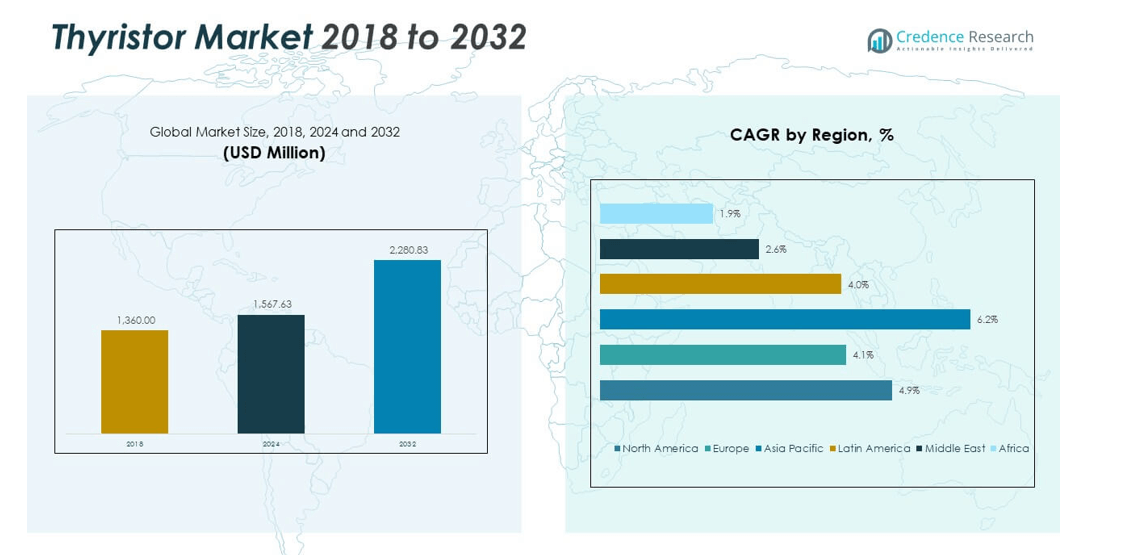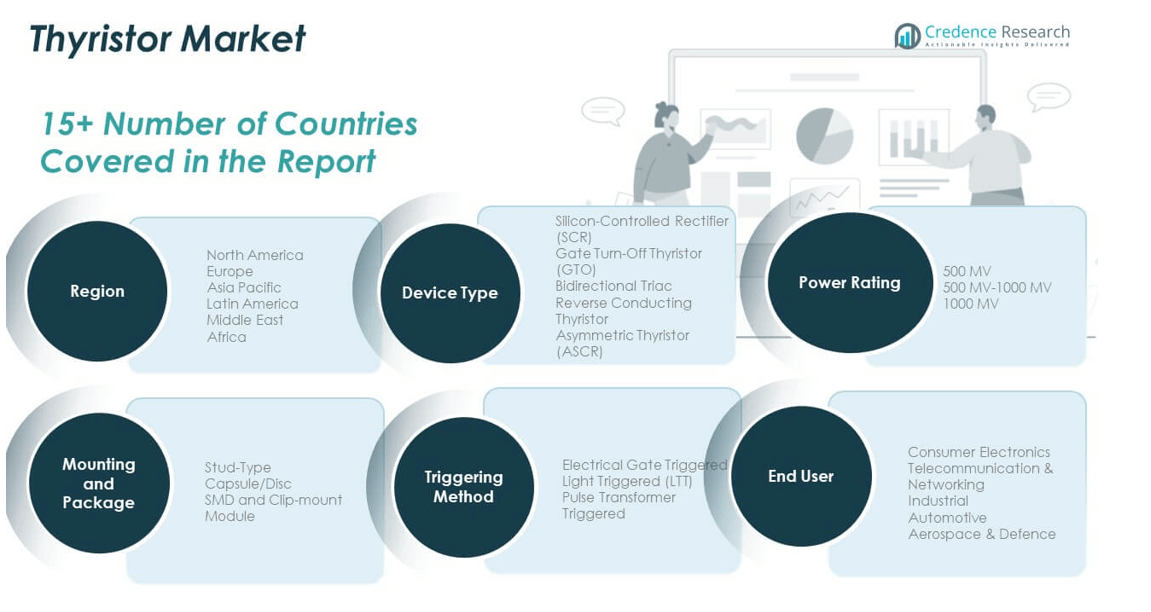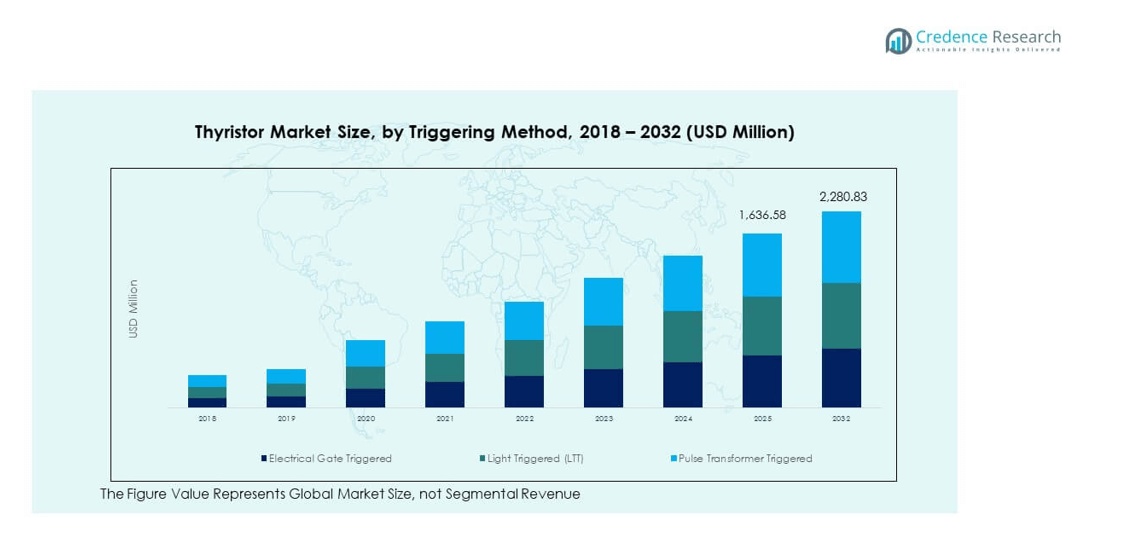CHAPTER NO. 1 : GENESIS OF THE MARKET
1.1 Market Prelude – Introduction & Scope
1.2 The Big Picture – Objectives & Vision
1.3 Strategic Edge – Unique Value Proposition
1.4 Stakeholder Compass – Key Beneficiaries
CHAPTER NO. 2 : EXECUTIVE LENS
2.1 Pulse of the Industry – Market Snapshot
2.2 Growth Arc – Revenue Projections (USD Million)
2.3. Premium Insights – Based on Primary Interviews
CHAPTER NO. 3 : THYRISTOR MARKET FORCES & INDUSTRY PULSE
3.1 Foundations of Change – Market Overview
3.2 Catalysts of Expansion – Key Market Drivers
3.2.1 Momentum Boosters – Growth Triggers
3.2.2 Innovation Fuel – Disruptive Technologies
3.3 Headwinds & Crosswinds – Market Restraints
3.3.1 Regulatory Tides – Compliance Challenges
3.3.2 Economic Frictions – Inflationary Pressures
3.4 Untapped Horizons – Growth Potential & Opportunities
3.5 Strategic Navigation – Industry Frameworks
3.5.1 Market Equilibrium – Porter’s Five Forces
3.5.2 Ecosystem Dynamics – Value Chain Analysis
3.5.3 Macro Forces – PESTEL Breakdown
3.6 Price Trend Analysis
3.6.1 Regional Price Trend
3.6.2 Price Trend by product
CHAPTER NO. 4 : KEY INVESTMENT EPICENTER
4.1 Regional Goldmines – High-Growth Geographies
4.2 Product Frontiers – Lucrative Product Categories
4.3 Power Rating Sweet Spots – Emerging Demand Segments
CHAPTER NO. 5: REVENUE TRAJECTORY & WEALTH MAPPING
5.1 Momentum Metrics – Forecast & Growth Curves
5.2 Regional Revenue Footprint – Market Share Insights
5.3 Segmental Wealth Flow – Device Type & Power Rating Revenue
CHAPTER NO. 6 : TRADE & COMMERCE ANALYSIS
6.1. Import Analysis by Region
6.1.1. Global Thyristor Market Import Revenue By Region
6.2. Export Analysis by Region
6.2.1. Global Thyristor Market Export Revenue By Region
CHAPTER NO. 7 : COMPETITION ANALYSIS
7.1. Company Market Share Analysis
7.1.1. Global Thyristor Market: Company Market Share
7.2. Global Thyristor Market Company Revenue Market Share
7.3. Strategic Developments
7.3.1. Acquisitions & Mergers
7.3.2. New Product Launch
7.3.3. Regional Expansion
7.4. Competitive Dashboard
7.5. Company Assessment Metrics, 2024
CHAPTER NO. 8 : THYRISTOR MARKET – BY DEVICE TYPE SEGMENT ANALYSIS
8.1. Thyristor Market Overview by Device Type Segment
8.1.1. Thyristor Market Revenue Share By Device Type
8.2. Silicon-Controlled Rectifier (SCR)
8.3. Gate Turn-Off Thyristor (GTO)
8.4. Bidirectional Triac
8.5. Reverse Conducting Thyristor
8.6. Asymmetric Thyristor (ASCR)
CHAPTER NO. 9 : THYRISTOR MARKET – BY POWER RATING SEGMENT ANALYSIS
9.1. Thyristor Market Overview by Power Rating Segment
9.1.1. Thyristor Market Revenue Share By Power Rating
9.2. 500 MV
9.3. 500 MV-1000 MV
9.4. 1000 MV
CHAPTER NO. 10 : THYRISTOR MARKET – BY MOUNTING AND PACKAGE SEGMENT ANALYSIS
10.1. Thyristor Market Overview by Mounting and Package Segment
10.1.1. Thyristor Market Revenue Share By Mounting and Package
10.2. Stud-Type
10.3. Capsule/Disc
10.4. SMD and Clip-mount
10.5. Module
CHAPTER NO. 11 : THYRISTOR MARKET – BY TRIGGERING METHOD SEGMENT ANALYSIS
11.1. Thyristor Market Overview by Triggering Method Segment
11.1.1. Thyristor Market Revenue Share By Triggering Method
11.2. Electrical Gate Triggered
11.3. Light Triggered (LTT)
11.4. Pulse Transformer Triggered
CHAPTER NO. 12 : THYRISTOR MARKET – BY END USER SEGMENT ANALYSIS
12.1. Thyristor Market Overview by End User Segment
12.1.1. Thyristor Market Revenue Share By End User
12.2. Consumer Electronics
12.3. Telecommunication & Networking
12.4. Industrial
12.5. Automotive
12.6. Aerospace & Defence
CHAPTER NO. 13 : THYRISTOR MARKET – REGIONAL ANALYSIS
13.1. Thyristor Market Overview by Region Segment
13.1.1. Global Thyristor Market Revenue Share By Region
13.1.2. Regions
13.1.3. Global Thyristor Market Revenue By Region
13.1.4. Device Type
13.1.5. Global Thyristor Market Revenue By Device Type
13.1.6. Power Rating
13.1.7. Global Thyristor Market Revenue By Power Rating
13.1.8. Mounting and Package
13.1.9. Global Thyristor Market Revenue By Mounting and Package
13.1.10. Triggering Method
13.1.12. Global Thyristor Market Revenue By Triggering Method
13.1.13. End User
13.1.14. Global Thyristor Market Revenue By End User
CHAPTER NO. 14 : NORTH AMERICA THYRISTOR MARKET – COUNTRY ANALYSIS
14.1. North America Thyristor Market Overview by Country Segment
14.1.1. North America Thyristor Market Revenue Share By Region
14.2. North America
14.2.1. North America Thyristor Market Revenue By Country
14.2.2. Device Type
14.2.3. North America Thyristor Market Revenue By Device Type
14.2.4. Power Rating
14.2.5. North America Thyristor Market Revenue By Power Rating
14.2.6. Mounting and Package
14.2.7. North America Thyristor Market Revenue By Mounting and Package
14.2.8. Triggering Method
14.2.9. North America Thyristor Market Revenue By Triggering Method
14.2.10. End User
14.2.11. North America Thyristor Market Revenue By End User
14.3. U.S.
14.4. Canada
14.5. Mexico
CHAPTER NO. 15 : EUROPE THYRISTOR MARKET – COUNTRY ANALYSIS
15.1. Europe Thyristor Market Overview by Country Segment
15.1.1. Europe Thyristor Market Revenue Share By Region
15.2. Europe
15.2.1. Europe Thyristor Market Revenue By Country
15.2.2. Device Type
15.2.3. Europe Thyristor Market Revenue By Device Type
15.2.4. Power Rating
15.2.5. Europe Thyristor Market Revenue By Power Rating
15.2.6. Mounting and Package
15.2.7. Europe Thyristor Market Revenue By Mounting and Package
15.2.8. Triggering Method
15.2.9. Europe Thyristor Market Revenue By Triggering Method
15.2.10. End User
15.2.11. Europe Thyristor Market Revenue By End User
15.3. UK
15.4. France
15.5. Germany
15.6. Italy
15.7. Spain
15.8. Russia
15.9. Rest of Europe
CHAPTER NO. 16 : ASIA PACIFIC THYRISTOR MARKET – COUNTRY ANALYSIS
16.1. Asia Pacific Thyristor Market Overview by Country Segment
16.1.1. Asia Pacific Thyristor Market Revenue Share By Region
16.2. Asia Pacific
16.2.1. Asia Pacific Thyristor Market Revenue By Country
16.2.2. Device Type
16.2.3. Asia Pacific Thyristor Market Revenue By Device Type
16.2.4. Power Rating
16.2.5. Asia Pacific Thyristor Market Revenue By Power Rating
16.2.6. Mounting and Package
16.2.7. Asia Pacific Thyristor Market Revenue By Mounting and Package
16.2.8. Triggering Method
16.2.9. Asia Pacific Thyristor Market Revenue By Triggering Method
16.2.10. End User
16.2.11. Asia Pacific Thyristor Market Revenue By End User
16.3. China
16.4. Japan
16.5. South Korea
16.6. India
16.7. Australia
16.8. Southeast Asia
16.9. Rest of Asia Pacific
CHAPTER NO. 17 : LATIN AMERICA THYRISTOR MARKET – COUNTRY ANALYSIS
17.1. Latin America Thyristor Market Overview by Country Segment
17.1.1. Latin America Thyristor Market Revenue Share By Region
17.2. Latin America
17.2.1. Latin America Thyristor Market Revenue By Country
17.2.2. Device Type
17.2.3. Latin America Thyristor Market Revenue By Device Type
17.2.4. Power Rating
17.2.5. Latin America Thyristor Market Revenue By Power Rating
17.2.6. Mounting and Package
17.2.7. Latin America Thyristor Market Revenue By Mounting and Package
17.2.8. Triggering Method
17.2.9. Latin America Thyristor Market Revenue By Triggering Method
17.2.10. End User
17.2.11. Latin America Thyristor Market Revenue By End User
17.3. Brazil
17.4. Argentina
17.5. Rest of Latin America
CHAPTER NO. 18 : MIDDLE EAST THYRISTOR MARKET – COUNTRY ANALYSIS
18.1. Middle East Thyristor Market Overview by Country Segment
18.1.1. Middle East Thyristor Market Revenue Share By Region
18.2. Middle East
18.2.1. Middle East Thyristor Market Revenue By Country
18.2.2. Device Type
18.2.3. Middle East Thyristor Market Revenue By Device Type
18.2.4. Power Rating
18.2.5. Middle East Thyristor Market Revenue By Power Rating
18.2.6. Mounting and Package
18.2.7. Middle East Thyristor Market Revenue By Mounting and Package
18.2.8. Triggering Method
18.2.9. Middle East Thyristor Market Revenue By Triggering Method
18.2.10. End User
18.2.11. Middle East Thyristor Market Revenue By End User
18.3. GCC Countries
18.4. Israel
18.5. Turkey
18.6. Rest of Middle East
CHAPTER NO. 19 : AFRICA THYRISTOR MARKET – COUNTRY ANALYSIS
19.1. Africa Thyristor Market Overview by Country Segment
19.1.1. Africa Thyristor Market Revenue Share By Region
19.2. Africa
19.2.1. Africa Thyristor Market Revenue By Country
19.2.2. Device Type
19.2.3. Africa Thyristor Market Revenue By Device Type
19.2.4. Power Rating
19.2.5. Africa Thyristor Market Revenue By Power Rating
19.2.6. Mounting and Package
19.2.7. Africa Thyristor Market Revenue By Mounting and Package
19.2.8. Triggering Method
19.2.9. Africa Thyristor Market Revenue By Triggering Method
19.2.10. End User
19.2.11. Africa Thyristor Market Revenue By End User
19.3. South Africa
19.4. Egypt
19.5. Rest of Africa
CHAPTER NO. 20 : COMPANY PROFILES
20.1. ABB Ltd
20.1.1. Company Overview
20.1.2. Product Portfolio
20.1.3. Financial Overview
20.1.4. Recent Developments
20.1.5. Growth Strategy
20.1.6. SWOT Analysis
20.2. Siemens AG
20.3. Schneider Electric SE
20.4. Eaton Corporation Plc.
20.5. Honeywell International Inc.
20.6. Analog Devices, Inc.
20.7. STMicroelectronics N.V.
20.8. Infineon Technologies AG
20.9. ON Semiconductor
20.10. Fuji Electric Co., Ltd.
20.12. Mitsubishi Electric
20.13. Bourns
20.14. Nihon Inter Electronics Corporation






